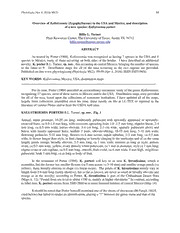
Overview of Kallstroemia (Zygophyllaceae) in the USA and Mexico, and description of a new species: Kallstroemia porteri PDF
Preview Overview of Kallstroemia (Zygophyllaceae) in the USA and Mexico, and description of a new species: Kallstroemia porteri
Phytologia (Apr 4, 2016) 98(2) 89 Overview of Kallstroemia (Zygophyllaceae) in the USA and Mexico, and description of a new species: Kallstroemia porteri Billie L. Turner TX Plant Resources Center, The University of Texas, Austin 78712 [email protected] ABSTRACT As treated by Porter (1969), Kallstroemia was recognized as having 7 species in the USA and 8 species in Mexico, many of these occurring on both sides of the border. I have described an additional novelty, K. porter B.L. Turner, sp. nov., this occurring in central Mexico, bringing the number of species in the latter to 9. Distribution maps for all of the taxa occurring in the two regions are provided. Published on-line www.phytologia.org Phytologia 98(2): 89-99 (Apr 4, 2016). ISSN 030319430. KEY WORDS: Kallstroemia Mexico, USA, distribution maps , For its time, Porter (1969) provided an extraordinary taxonomic study of the genus Kallstroemia , recognizing 17 species, most of these native to Mexico and/or the USA. Distribution maps were provided for all of the taxa, based upon the collections of numerous institutions. I have updated all of the maps, largely from collections assembled since his time, these mostly on file at LL-TEX or reported in the literature of various Floras and/or from the USDA web sites. KALLSTROEMIA PORTERI B.L. Turner, sp. nov. Fig. 1 Annual, stems prostrate, 10-20 cm long, moderately pubescent with upwardly appressed or upwardly- mm mm recurved hairs, ca 0.5-1.0 long, with occasions spreading hairs 1.0 -1.5 long; stipules linear, 2-4 mm mm long, ca 0.5 wide; leaves obovate, 3-4 cm long, 2-3 cm wide, sparsely pubescent above and mm mm below with mostly appressed hairs; leaflets 3 pairs, obovate-oblong, 10-15 long, 5-10 wide; mm mm mm mm flowering peduncles 5-10 long; flowers ca 6 across; sepals subulate, 2-3 long, ca 0.5 wide, in flower longer than style, in fruit clasping or loosely clinging to the mericarps and of ca the same mm mm length; petals orange, broadly obovate, 2-3 long, ca 1 wide; stamens as long as style; anthers mm mm mm ovate, ca 0.5 wide, yellow; ovary densely white-pubescent, ca 1 in diameter; style ca 1 long; mm mm mm stigma ovate or sub-capitate, ca 0.5 long, smooth; fruit ovoid, ca 6 wide, 4 high, strigillose- mm pubescent; beak 3 long, ca as long as body of fruit. In the treatment of Porter (1969), K. porteri will key to or near K. hirsutissima, which it mm resembles, but the former has smaller flowers (ca 5 across vs 5-10 mm) and smaller orange petals (vs yellow), these broadly obovate in shape (vs linear-ovate). The petals of K. hirsutissima mostly vary in mm length from 3-6 long (rarely abortive), but so far as known, are never as small or broadly obovate and orange as in the novelty; according to Porter, K. hirsutissima is part of the Chihuahuan Desert flora (Maps 6, 12), “Found from sea level to about 1700 m, mainly at higher elevations.” In contrast, according m to label data, K. porteri occurs from 2000-2800 in more forested habitats of central Mexico (Map 14). It should be noted that Porter himself examined one of the sheets of this taxon McVaugh 16628, (. cited below) but failed to render an identification, placing a “?” between the genus name and that of the species. 90 Phytologia (Apr 4, 2016) 98(2) TYPE: MEXICO. PUEBLA: Mpio. Caltepec, “Cerro El Gavilan, al SE de Caltepec,” ca 2320 m, 18° 12' N, 97° 30' W, reportedly locally abundant in igneous soils, 14 Jul 1986, Pedro Tenorio L. 11799 [with A. Salinas T. & Dawn Frame] (Holotype: TEX). ADDITIONAL SPECIMENS EXAMINED: MEXICO. AGUASCLIENTES: “Highway to Ojuelos,” 9 mi E of Aguacalientes, 2000 m, “Brush-covered hills among shrubs and small trees...Abundant, intermixed with K. rosei.” 8-9 Aug 1958, McVaugh 16628 (TEX). GUANAJUATO: Mpio. San Luis de la Paz, “Cerca de Pregon,” 2100 m, 22 Aug 1988, Rzedowski 47068 (TEX). PUEBLA: Mpio. Caltepec, W Barranca del Agua Frio, 1.5 km of San Luis Atolotitlan, 2100-2800 m, 5 Jul 1983, Tenorio L. 4038 (TEX). It's a pleasure to name this taxon for Duncan M. Porter, who contributed an exceptional study of the genus in 1969, for its time very through at every level. He is still deeply involved in things systematic as an Emeritus Professor of Biological Sciences at Virginia Tech University. ACKNOWLEDGEMENTS Jana Kos provided editorial input; dot maps are largely based upon the citations of Porter (1969) and specimens on file at LL-TEX (cf. Turner et al. 2003), except as noted in the above first paragraph. LITERATURE CITED Porter, D.M. 1969. The genus Kallstroemia (Zygophyllaceae). Contr. Gray Herb. 198: 41-153. Turner, B.L. et al. 2003. Kallstroemia in Sida, Bot. Misc. 24, Atlas of the Vascular Plants of Texas 1: , 616-617. 5 Phytologia (Apr 4, 2016) 98(2) 91 tTsi.itr^ tijJls|:rcienu.lpucirrilt,[, |urnT.E IVlrR1,Tumor3)1 PLAMrflS PE MEXICO) PUEBLA Herbi. io National dr Mmico (HEXO) Institute de EHotogia. UNAM ®tClOPJfillACEAE KaHattOcaila hirsutismSitu Vail Get.'Ang&tica Ramirez Etoa iflrm Loc. Crrro El Gavllan, »1 St do taltepec:, flpio, Calti^sc HAiietr.-b2a32p0osimrsandma,, OalbuSndIaSntQ*0,<Nfi|., 0a9m7anJitita00 iW) SUsu.jt,UiMenteegrrroaIsaobcrpeinarsoocacotngotrorasicaulrj, pnmafl,. Feetiai lit Jul i98t. Col. Pedro Tenorio L_, No. II7W, A, Selinas T,, Dawn Frise Balo el Pairoeinio d« CONACYT 00289226 Figl. Holotype, Kallstroemia porteri. 92 Phytologia (Apr 4, 2016) 98(2) KHLLSIROEMtH cafifornica Map 1 KRLLSTRflEMIB grandiflora Map 2 Phytologia (Apr 4, 2016) 98(2) 93 KflUSTROEMIfl hirsutissima Map 3 94 Phytologia (Apr 4, 2016) 98(2) KRLLSTROEMIR • permnans o pubescens [introduced] Map 6 Phytologia (Apr 4, 2016) 98(2) 95 96 Phytologia (Apr 4, 2016) 98(2) Phytologia (Apr 4, 2016) 98(2) 97 98 Phytologia (Apr 4, 2016) 98(2)
